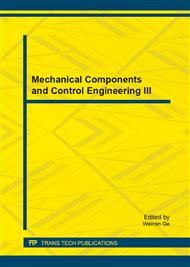p.281
p.285
p.289
p.294
p.298
p.302
p.306
p.310
p.314
Treatment of Substructure Rigid-Body Modes in Close-Loop Coupling Disc Brake Squeal Model
Abstract:
It’s found that the rigid-body modes of brake pads and brake caliper have significant influence on squeal occurrence while analyzing disc brake squeal problems using close-loop coupling disc brake squeal model. The modal shapes of these rigid-body modes calculated from finite element method (FEM) are linear combination of multiple translational and rotational motions, which is unfavorable for further analysis. In this paper, method to achieve ‘pure’ rigid-body modes such as translations along and rotations on its principal axes of inertia is presented. Modal shapes derived from this method consist with those from FEM model under suitable constraints. The result is used in substructure modal composition analysis on a disc brake squeal problem, where the effects of specific rigid-body modes can be shown clearly. The method is helpful for researchers to choose right measures to suppress squeals.
Info:
Periodical:
Pages:
298-301
Citation:
Online since:
October 2014
Authors:
Price:
Сopyright:
© 2014 Trans Tech Publications Ltd. All Rights Reserved
Share:
Citation:


